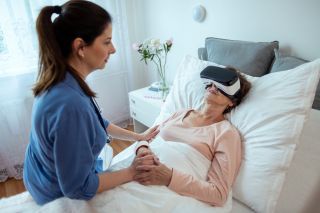Caregiving
The Use of Virtual Reality in Hospice
There can be benefits of using virtual reality for the dying.
Updated August 9, 2023 Reviewed by Ray Parker
Key points
- Virtual reality is now being used to improve physical and mental health.
- Some hospices that use it have been pleased with the results.
- Patients often use the VR experience as a way to cross off items from their “bucket list."

Virtual reality (VR) has been found to be beneficial in promoting wellness in our lives. In medicine, it has been used to decrease pain and anxiety. Surgeons can use VR to learn and practice their skills before they work with a patient.
VR has helped to improve balance and mobility in those with Parkinson’s disease. In cancer treatment, it was found that when using VR there was an improvement in the level of pain and fatigue. In the field of mental health, VR has been shown to be effective in treating anxiety disorders, obsessive-compulsive disorder (OCD), phobias, post-traumatic stress disorder (PTSD), and eating disorders.
Virtual Reality in Palliative Care: A New Tool for Comfort and Connection
Now we are starting to see VR being used in palliative care. One hospice program that has been using VR for the past two years is The Brookings Health System Hospice located in South Dakota. It offers outpatient care for the community.
I had the opportunity to talk with Donna Bumann, a social worker at the hospice who has been actively involved in the VR program since its inception. She states that the training was done through webinars. Volunteers with the hospice have also received training with the VR system.
Bumann says that there are six different categories from which the patients can choose: travel, pets, nature, music, arts, learning, and adventure. There are also some systems that will even let family members record experiences, such as weddings, graduations, or family reunions. Even though the patient is unable to physically be there, they can still participate in the event.
According to Bumann, the overall results have been very positive from all involved, from the patients and family to the staff. They have found that sometimes amazing things can happen in a session.
VR Helps Patients With Dementia Reconnect With Loved Ones
She related two accounts of patient experiences with VR. Bumann states that one patient with dementia and his wife chose to view a trip to Jerusalem, a place they had visited in the past. The patient, who was generally incoherent, was able to recognize places in the city they had visited.
This led to him and his wife having a coherent conversation about what they had seen and experienced. It was quite thrilling for the staff to see him interacting with his wife in a way he had not been able to before.
Another example involved a hospice patient in a nursing home. She enjoyed VR because she was able to travel to different countries. She also loves birds and enjoyed the videos that featured the different species of birds. She would share her experiences when the family came to visit. The patient graduated from hospice and is said to have a new zest for life and wants to live each moment to the fullest.
Patients often use the VR experience as a way to cross off items from their “bucket list” and at least be able to have some of their last wishes met. People have taken virtual tours of the Grand Canyon, the pyramids, and of the Louvre in Paris. One woman, a skydiver was able to experience one last jump from her hospice bed.[1]
VR Can Help Staff and Volunteers Better Understand the Dying Process
In addition to helping the patients, VR can also be a tool for staff and volunteers in order to provide them with an opportunity to better understand the dying process. They experience what it is like to be a 66-year-old patient, Clay Crowder, who is actively dying of incurable lung cancer.
It begins with the doctor telling you that your treatments are no longer working and that you are dying. You see the world through the patient's eyes and ears. Your family is by your side talking and reading to you. They tell you that it is ok to let go and you experience leaving your body.
Participating in this is said to have a strong impact on those who have seen it. Being a part of Crowders' dying has been found to help increase staff’s empathy for patients as well as helping to decrease staff “burnout.” [2]
What we now know is that we can open up the dying world. They are no longer just confined to their beds, waiting to die. VR has been found to improve pain management. It reduces anxiety and depressive symptoms.
It gives the patient a respite and distraction from their current situation. It improves the patient's comfort level as well as their mood. It also serves to decrease feelings of loneliness and isolation.
Bumann states that being able to provide these experiences for the dying has been “good for her soul,” knowing that she is helping to bring meaning to the dying’s life.




